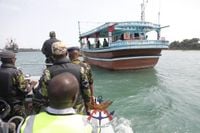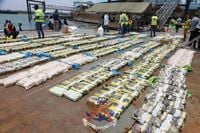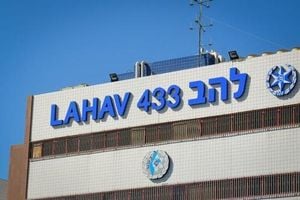In a dramatic show of international cooperation and maritime might, the Kenya Navy has intercepted a stateless dhow carrying more than a ton of methamphetamine, marking one of the largest narcotics seizures in the country’s history. The operation, which unfolded some 630 kilometers east of Mombasa’s coastline on Saturday, October 25, 2025, has been hailed by authorities as a major breakthrough in Kenya’s ongoing fight against narcotics trafficking and addiction.
The vessel, codenamed IGOR, had been on the radar of international drug enforcement agencies for months, slipping through crackdowns and evading authorities until its capture. According to AP and corroborated by multiple Kenyan news outlets, the dhow was intercepted during a coordinated mission involving the Kenya Defence Forces (KDF), the Regional Coordination Operations Centre (RCOC) in Seychelles, and the Regional Maritime Information Fusion Centre (RMIFC) in Madagascar. Surveillance support came from the Seychelles government, which provided a maritime patrol aircraft to aid in tracking the vessel across the Indian Ocean.
The operation, code-named Bahari Safi 2025.01 and conducted under the Safe Seas Africa (SSA) Programme, saw the deployment of the Kenya Navy Ship (KNS) Shupavu and a Dornier Maritime Patrol Aircraft operated by the Seychelles Coast Guard. After the dhow was sighted east of Mombasa, Kenyan Navy sailors executed a “visit, board, search and seizure” maneuver, ultimately towing the vessel to the port of Mombasa under armed guard. The six Iranian crew members aboard the dhow initially refused to comply with orders to slow down, forcing the Navy to board the ship by force, according to Brigadier Sankale Kiswaa, Deputy Commander of the Kenya Navy and leader of the multi-agency operation.
Once secured, the vessel was handed over to a multi-agency security team led by the National Police Service (NPS), including the Directorate of Criminal Investigations (DCI) and other law enforcement agencies. Court warrants were quickly obtained, allowing for a detailed inspection and forensic testing of the cargo. Preliminary tests confirmed that the suspicious crystalline substance was indeed methamphetamine—1,024 kilograms of it, concealed in black polythene bags wrapped with yellow tape labeled “100 percent roasted and grounded Arabica coffee.” Police uncovered 769 separate packages of the drug, carefully hidden within the vessel’s compartments.
The street value of the haul is estimated at approximately 8.2 billion Kenyan shillings, or about $63 million, making it the second-largest narcotics seizure in Kenyan history by weight. To put that in perspective, the only larger bust occurred in 2006, when authorities seized 1.1 tonnes of cocaine valued at 6 billion shillings. In 2014, more than 300 kilograms of heroin, worth 1.3 billion shillings, were confiscated in a separate operation. Methamphetamine prices in the region are staggering, with a single gram fetching between 8,000 and 10,000 Kenyan shillings on the street.
The six Iranian nationals arrested in the operation are now in custody, facing prosecution under strict legal and procedural safeguards. The multi-agency investigation, which remains ongoing, aims to trace the drugs’ origin and intended destination, as well as to dismantle the broader cartel believed to be operating along the East African coast. The dhow IGOR, which had previously managed to evade international crackdowns, is thought to be part of a sophisticated network exploiting Kenya’s strategic position on the so-called “southern route” linking South America to South Africa and beyond.
Kenya’s Anti-Narcotics Director Samuel Laboso highlighted the country’s growing challenge with synthetic drug trafficking and consumption. “There has been a rise in methamphetamine peddling and consumption in the region, specifically because of the country’s strategic position on the southern route linking South America to South Africa and the rest of the world,” Laboso explained. He noted that authorities had recently busted methamphetamine factories in Namanga and Diani, further underscoring the scale and complexity of the problem.
Anthony Omerikwa, CEO of the National Authority for the Campaign against Alcohol and Drug Abuse, added that methamphetamine has even been detected in some shisha establishments, signaling a worrying trend in the proliferation of synthetic drugs in Kenya’s urban centers. The country’s coastline, in particular, has been hard hit, with hundreds of young people struggling with meth and heroin addiction, according to AP.
Brigadier Sankale Kiswaa, the Navy’s Deputy Commander, emphasized the importance of regional collaboration in combating illicit maritime activities. “The Kenya Navy, in collaboration with the relevant competent authorities, continues to ensure that the vessel, its cargo, and crew are handled in strict compliance with legal and procedural safeguards necessary for successful prosecution and regional accountability,” he told journalists, as reported by People Daily and other outlets. He also noted that the successful interception demonstrates Kenya’s growing capacity to police its territorial waters and disrupt transnational organized crime.
The operation’s success has been widely praised by Kenyan officials. The National Police Service commended the professionalism and coordination among agencies involved, stating, “NPS remains dedicated to working collaboratively with other agencies to combat drug trafficking.” The Ministry of Defence hailed Operation Bahari Safi as a testament to Kenya’s strengthened maritime surveillance and intelligence-sharing mechanisms with regional and international partners.
But the victory is bittersweet. Methamphetamine, commonly known as meth, is a potent and highly addictive stimulant that affects the central nervous system. Prolonged use can lead to devastating consequences, including psychosis, heart failure, and irreversible brain damage. The record-breaking seizure is a stark reminder of the scale of the synthetic drug crisis facing Kenya, particularly along its vulnerable coastline.
As the multi-agency investigation continues, authorities remain tight-lipped about the specific origins and intended destination of the methamphetamine. What is clear, however, is that the interception of IGOR has delivered a significant blow to international drug trafficking networks operating in the Western Indian Ocean. The operation also underscores the critical importance of intelligence sharing and cooperation among regional maritime partners—a lesson that will no doubt inform future efforts to keep Kenya’s waters, and its people, safe from the scourge of narcotics smuggling.
For now, the focus shifts to the courts and the ongoing search for those higher up the smuggling chain. But one thing is certain: Kenya’s message to international drug traffickers is clear—its navy and law enforcement agencies are watching, ready, and increasingly capable of striking back.





